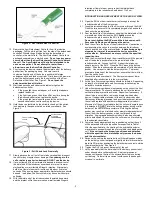
- 1 -
Azur
Peripheral
Coil System
Helical HydroCoil
®
Embolization System
(Pushable)
Instructions for Use
DEVICE DESCRIPTION
The Pushable Azur Peripheral Coil System (Azur system) consists of a
coil implant packaged in a coil introducer along with an introducer stylet.
The coil is platinum-based with an outer layer of hydrogel polymer.
The Azur system is available in helical 18-system and helical 35-system
configurations. Both configurations are available in a broad range of
secondary diameters and lengths to meet the needs of the physician.
Each system must be delivered through a microcatheter or catheter
within the specified ID range, using a specified guidewire size.
System
Catheter/Microcatheter ID
inches
mm
18-system
0.021 – 0.022
0.53 – 0.56
35-system
0.041 – 0.047
1.04 – 1.19
System
Guidewire OD
inches
mm
18-system
0.018
0.46
35-system
0.035
0.89
INDICATIONS FOR USE
The Azur system is intended to reduce or block the rate of blood flow in
vessels of the peripheral vasculature. It is intended for use in the
interventional radiologic management of arteriovenous malformations,
arteriovenous fistulae, aneurysms, and other lesions of the peripheral
vasculature.
This device should only be used by physicians who have undergone
training in the use of the Azur system for embolization procedures as
prescribed by a representative from Terumo
or a Terumo-authorized
distributor.
CONTRAINDICATIONS
Use of the Azur system is contraindicated in any of the following
circumstances:
When superselective coil placement is not possible.
When end arteries lead directly to nerves.
When arteries supplying the lesion to be treated are not large
enough to accept emboli.
When the A-V shunt is larger than the coil.
In the presence of severe atheromatous disease.
In the presence of vasospasm (or likely onset of vasospasm).
POTENTIAL COMPLICATIONS
Potential complications include, but are not limited to: hematoma at the
site of entry, vessel/aneurysm perforation, unintentional occlusion of the
parent artery, incomplete filling, emboli, hemorrhage, ischemia,
vasospasm, edema, coil migration or misplacement, clot formation,
revascularization, post-embolization syndrome, and neurological deficits
including stroke and possibly death.
REQUIRED ADDITIONAL ITEMS
Appropriately-sized catheter/microcatheter (with wire reinforcement
required for delivery through tortuous vasculature)
Steerable guidewire compatible with coil system and delivery
catheter/microcatheter
Rotating hemostatic Y valve (RHV)
Sterile saline
Pressurized sterile saline drip
One-way stopcock
1cc syringe
WARNINGS AND PRECAUTIONS
Federal law (USA) restricts this device to sale by or on the
order of a physician.
The Azur system is sterile and non-pyrogenic unless the unit
package is opened or damaged.
The Azur system is intended for single use only. Do not reuse,
reprocess or resterilize. Reuse, reprocessing or resterilization may
compromise the structural integrity of the device and/or lead to
device failure which, in turn, may result in patient injury, illness, or
death. Reuse, reprocessing, or resterilization may also create a
risk of contamination of the device and/or cause patient infection or
cross-infection, including, but not limited to, the transmission of
infectious disease(s) from one patient to another. Contamination of
the device may lead to injury, illness or death of the patient.
Angiography is required for pre-embolization evaluation, operative
control, and post-embolization follow up. Fluoroscopic
roadmapping is recommended to achieve optimal device
placement.
Always inspect the Azur system prior to both preparation and
insertion to ensure that the coil has not shifted within the introducer
or migrated into the introducer caps. If the coil is not secure within
the introducer prior to both the preparation and introduction
processes, damage may result.
Hydration of the Azur
system prior to use is
mandatory
.
A 3-
minute hydration period is required to soften the coil. Failure to
hydrate may result in the coil not taking its secondary shape, which
can result in deployment away from the intended location,
migration, or protrusion outside the delivery location.
The coil must be delivered through a compatibly-sized catheter or
microcatheter with a PTFE inner surface coating using a
compatibly-sized guidewire. Failure to correctly size the delivery
system may result in damage to the device and necessitate
removal of both the device and delivery catheter from the patient.
Always select a wire-reinforced delivery catheter/microcatheter
when delivering the coil through highly tortuous vasculature. Non-
reinforced catheters may ovalize under such circumstances,
potentially resulting in coil damage and necessitating removal of
both the device and delivery catheter from the patient.
Do not use a syringe to deliver the coil. The coil is intended to be
delivered using a compatible guidewire only. Delivery via syringe
injection may result in the coil not taking its secondary shape,
which can result in deployment away from the intended location,
migration, or protrusion outside the delivery location.
Do not advance the coil with excessive force. If unusual resistance
is noted during advancement, determine its cause before
proceeding by verifying the appropriate delivery catheter and
guidewire are being used, and that both are free from damage and
kinking. If necessary, replace the delivery catheter, coil, and/or
guidewire before proceeding.
The coil is not retractable or repositionable. If a coil must be
retrieved from the vasculature after deployment, do not attempt to
withdraw the coil with a retrieval device, such as a snare, into the
delivery catheter. This could damage the coil and result in device
separation. Remove the coil, microcatheter, and any retrieval
device from the vasculature simultaneously.
If the coil and/or pushing guidewire get stuck within the delivery
catheter lumen, do not continue advancing. Remove the catheter,
and replace the catheter, coil, and/or guidewire when necessary.
Delivery of multiple coils is generally required to achieve the
desired occlusion of some vessels, aneurysms, and vascular
lesions. The desired procedural endpoint is angiographic
occlusion. The filling properties of the coil facilitate angiographic
occlusion and reduce the need to tightly pack. Multiple
embolization procedures may be required to achieve the desired
occlusion of some vessels/vascular lesions.























